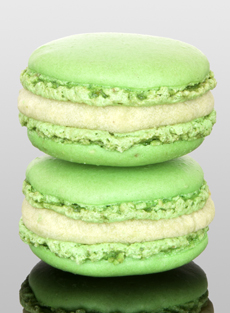TIP OF THE DAY: Green Macarons
|
Paris may not be as festive as Dublin or New York when it comes to celebrating St. Patrick’s Day; but rest assured, there are celebrations! Both expats and locals head to the city’s numerous Irish pubs and yes, there is green beer. (Who knew that Paris had “numerous Irish pubs?” Source)
We, however, would head to Ladurée or Pierre Hermé for pistachio macarons, a classic flavor where the meringue is colored green. You don’t have to head to Paris. If there are no macarons in your neck of the woods, you can order them from Dana’s Bakery, Macaron Café or Mad Mac. There are also Ladurée outposts in New York City and Miami, but we couldn’t find online ordering options for either. Dana’s Bakery, which doesn’t make classic flavors*, has two green options right now: Key Lime Pie and Thin Mint. So if pistachio nuts are not your thing, she’s your gal. While a classic pistachio macaron is filled with pistachio or vanilla ganache, or possibly chocolate ganache, we’ve found varieties from creative macaron artists that feature matcha ganache, peanut butter ganache, red bean jam and other fillings (like Dana’s chocolate mint and Key lime). Whatever your preference, include a bit of France in your St. Patrick’s Day celebration. |
 Plan in advance: green macarons (pistachio) for St. Patrick’s Day. Photo courtesy Pierre Hermé. |
|
|
*The current flavors at Dana’s Bakery include Birthday Cake, Cookie Dough, Cotton Candy, Fruity Cereal, Jelly Doughnut, Orange Creamsicle, Peanut Butter & Jelly, S’mores and Strawberry Shortcake, among others. |
||
|
|
WHO INVENTED MACARONS? The ganache-filled meringue cookie sandwiches shown above are called Parisian macarons. The first macaroons, from Italy, were quite different: almond meringue cookies similar to today’s amaretti, with a crisp crust and a soft interior (see the photo at left). The name derived from the Italian maccarone or maccherone, itself derived from ammaccare, meaning to crush or to beat. (The reference is to the crushed almonds or almond paste, which is the principal ingredient.) These original macaroons arrived in France in 1533 with the pastry chefs of Catherine de Medici, who married France’s King Henri II. More than two centuries later, two Benedictine nuns, seeking asylum in the town of Nancy during the French Revolution (1789-1799), paid for their housing by baking and selling the cookies. |
|
|
According to Wikipedia, “[Pâtisserie] Ladurée’s rise to fame came in 1930 when his grandson, Pierre Desfontaines Ladurée, had the original idea of the double-decker, sticking two macaron shells together with a creamy ganache as filling. The first versions combined two plain almond meringues with a filling of chocolate ganache; but today, various varieties of ganache, buttercream or jam are sandwiched between meringues of seemingly limitless colors and flavors. Other stories variously give the invention date as “the beginning of the 20th century” and 1952. The latter date has credence if you believe the blog ParisPatisseries.com, that in 2012, Laduree hosted a 60th anniversary party for the macaron. Here’s the history of macarons. Italian Jews adopted the cookie because it has no flour or leavening, and thus can be enjoyed during the eight-day observation of Passover. It was introduced to other European Jews and became popular as a year-round sweet. Over time, coconut was added to the ground almonds and, in certain recipes, replaced them. When the coconut cookies arrived in England and the U.S., macaron became macaroon. Until the Parisian macaron craze began within the last ten years, coconut macaroons were far more prevalent in the U.S. and the U.K. They’re a lot easier to make and transport than the fragile Parisian variety. A tasting plate of amaretti, coconut macaroons and Parisian macarons would be an excellent “educational dessert.”
|
||



